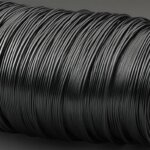Table of Contents
Fiber optics technology, also known as optical fiber technology, is a revolutionary technology that utilizes long, thin strands of glass or plastic fibers to transmit light signals for various applications. These fiber optic cables, arranged in bundles, are capable of carrying light signals over long distances at high speeds. Initially developed in the 1950s for medical endoscopes, fiber optics quickly gained popularity among telephone engineers for telecommunications purposes. Today, fiber optics are extensively used for signal transmission, communication, and vision (video) purposes in various industries.
Fiber optics technology offers several benefits, including high bandwidth capacity, electrical isolation, immunity to electromagnetic interference, low power loss, and compact size compared to traditional copper cables. It has become an integral part of industries such as telecommunications, computer networking, broadcasting, internet connectivity, cable television, undersea environments, military operations, space exploration, and medical advancements.
How Does Fiber Optics Work?
Fiber optics work by transmitting data in the form of light particles, or photons, through a fiber optic cable. The cable consists of a glass or plastic fiber core, a cladding layer, a buffer tube layer, and an outer jacket layer for protection.
Light signals are encoded with data at the transmitting end and travel down the fiber optic cable by bouncing off the walls of the cable in a series of zig-zag bounces, following a process called total internal reflection. This mechanism allows the light signals to stay confined within the core of the cable and prevents them from escaping through the sidewalls.
The light signals travel down the core of the cable, while the cladding layer, made of the same material as the core but with a slightly lower refractive index, keeps the light signals inside the core. The light signals can travel long distances at high speeds, although they do travel about 30% slower than the speed of light due to the denser glass layers.
“Fiber optics work by transmitting data in the form of light particles, or photons, through a fiber optic cable.”
To maintain the signal’s strength throughout the journey, fiber optics transmission may require repeaters at certain intervals. These repeaters regenerate the optical signal by converting it to an electrical signal, processing it, and retransmitting it as an optical signal.
Signal regeneration in fiber optics plays a crucial role in ensuring that the transmitted data remains clear and accurate, even over long distances. By converting the optical signal into an electrical signal and then back into an optical signal, the information is refreshed and able to continue its journey with minimal degradation.
The working of fiber optics, including light transmission, total internal reflection, and signal regeneration, enables the efficient and reliable transmission of data for a wide range of applications, from telecommunications to medical imaging.
Types of Fiber Optic Cables
In the world of fiber optics, there are two primary types of cables that are commonly used: single-mode fiber and multimode fiber. These cables have distinct characteristics and are designed for specific purposes.
Single-Mode Fiber
Single-mode fiber, as the name suggests, is designed to carry a single beam of light through its smaller core diameter. This type of fiber optic cable is ideal for long-distance transmission as it minimizes signal attenuation and provides a more direct route for the light signal. Single-mode fiber is known for its higher bandwidth capacity compared to multimode fiber, making it suitable for applications such as CATV, internet, and telephone systems.
Multimode Fiber
In contrast, multimode fiber has a larger core diameter, allowing multiple light pulses to be transmitted simultaneously. This enables greater data transmission but also increases the possibility of signal loss and interference. Multimode fiber is commonly used for shorter distances and is often found in computer network interconnections.
To differentiate between different types of multimode fiber cables, the industry uses the “OM” designation, which stands for optical multimode. The most common types include OM1, OM2, OM3, and OM4, each with its own specifications and applications. These multimode fiber cables are chosen based on requirements such as bandwidth, distance, and cost.
Fiber optic cables can also be designed to meet industry-specific installation requirements. One example is the use of plenum cables, which comply with specific flame and toxicity standards for safe installation in air plenum spaces within buildings.
Comparison of Single-Mode and Multimode Fiber
| Aspect | Single-Mode Fiber | Multimode Fiber |
|---|---|---|
| Core Diameter | Smaller | Larger |
| Signal Attenuation | Reduced | Possibility of signal loss and interference |
| Bandwidth Capacity | Higher | Lower |
| Distance | Longer | Shorter |
| Applications | CATV, internet, telephone | Computer network interconnections |
Both single-mode and multimode fiber have their own strengths and are chosen based on the specific requirements of the application. Understanding the differences between these fiber optic cable types allows for better decision-making when it comes to designing and implementing fiber optic networks.

Advantages and Uses of Fiber Optics
Fiber optics technology offers numerous advantages over traditional copper cables, making it the preferred choice in a wide range of applications. One of the key advantages is its higher bandwidth capacity, allowing for faster and more efficient data transmission. Unlike copper cables, which have limitations in terms of data speed, fiber optics can support higher data rates, making it ideal for bandwidth-intensive tasks.
Another significant advantage of fiber optics is its ability to transmit data over longer distances without any signal degradation. Copper cables experience signal loss over long distances, requiring the use of repeaters to amplify the signal. Fiber optic cables, on the other hand, can transmit data over much greater distances, reducing the need for signal regeneration and improving overall transmission efficiency.
Furthermore, fiber optics is immune to electromagnetic interference (EMI), making it highly reliable and resistant to disruptions caused by nearby electronic devices or power lines. This immunity to EMI allows fiber optic cables to maintain signal integrity even in challenging electromagnetic environments, ensuring consistent and high-quality data transmission.
In terms of applications, the versatility of fiber optics is truly impressive. It finds extensive use in various industries, including telecommunications, where it enables the fast and reliable transmission of voice, data, and video signals. Fiber optics is also widely used in local area networks (LANs), industrial control systems, avionic systems, military command and communications systems, and medical applications, among others.
When compared to copper cables, fiber optics offer several advantages. However, it is essential to consider potential drawbacks. Fiber optic cables can be more expensive to install and maintain than copper cables. They also require careful handling and protection to prevent signal loss, especially when bent or curved tightly. Despite these considerations, the benefits of fiber optics make it an indispensable technology in today’s digital world.
FAQ
What is fiber optics technology?
Fiber optics technology, also known as optical fiber technology, uses long, thin strands of glass or plastic fibers to transmit light signals for various purposes.
What are the benefits of fiber optics?
Fiber optics provide several benefits, including high bandwidth, electrical isolation, immunity to electromagnetic interference, low power loss, and smaller size compared to copper cables.
How does fiber optics work?
Fiber optics work by transmitting data in the form of light particles, or photons, through a fiber optic cable using a process called total internal reflection.
What are the types of fiber optic cables?
There are two primary types of fiber optic cables: single-mode fiber and multimode fiber.
What are the advantages of fiber optics over copper cables?
Fiber optics offer advantages such as higher bandwidth capacities, longer transmission distances, immunity to electromagnetic interference, and the ability to be submerged in water.
Where are fiber optics used?
Fiber optics are used in various industries, including telecommunications, computer networking, broadcasting, internet, cable television, undersea environments, military, space, and medical.







